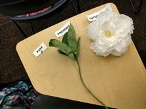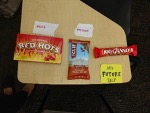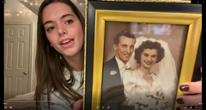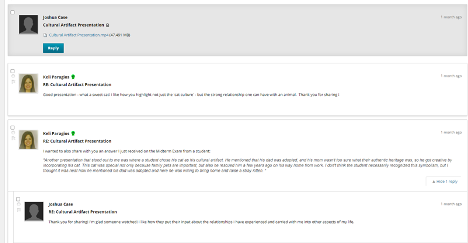Course: GAD 250 – Business Communications
Department: Marketing
Institution: Cleveland State University
Instructor: Keli Pontikos Paragios
Number & Level of Students Enrolled: Spring 2019 = 18 students; Fall 2019 = 99 students; Spring 2020 = 56 students; Fall 2020 = 65 students (Total = 8 sections, 238 students)
Digital Tools/Technologies Used: Blackboard (Discussion Board, Groups, TurnItIn)
Author Bio: Keli Pontikos Paragios holds a Bachelor’s in Communication from Bowling Green State University and a Masters in Teaching from the University of Tampa. She has taught in multiple learning environments, from elementary to college, since 2008. Currently, she is an educator and learner at Cleveland State University. She has completed her Ph.D. courses and comprehensive exams in the Adult, Continuing, and Higher Education program, and is currently working on her dissertation research. Her favorite thing to do is travel to Athens, Greece annually for the Athens Institute of Research Education Conference. In her spare time, she answers emails from students.
ABSTRACT: In the ancient ruins of the Temple of Delphi in Athens, Greece, is the inscription from Socrates, “Know Thyself.” But how does one know their true self, and more importantly, become their own self? By understanding that identity is a layering of events and experiences in which they have been involved, students investigate the meaning that they have acquired from multiple facets of their lives, as well as the knowledge that their perception, at times, requires revision. Through these different contexts, they investigate one of the most critical aspects of identity construction; the intersectionality of multiple factors, such as structure, culture, and context. This case study is a discussion of a higher education business communication course with the intention of increasing student self-awareness through self-exploration. The overarching goal is to enhance students’ employability by supplementing the coursework with complementary activities and tasks meant to improve students’ knowledge of themselves, thus improving employability chances in today’s competitive labor market. Presented are assignments utilized in a Business Communications course in 2020. These assignments were modified and successfully applied in a remote learning environment during the CoVid-19 pandemic. This case study illustrates the potential value of enhancing student exploration in higher education curriculum development, as well as being transferable to pedagogical experiences.
Introduction
Every day when I enter my classroom, I believe that my students will obtain knowledge which is central to them becoming lifelong learners and productive members of society. As an educator for over ten years, I have been trained to be a critical analyst, stimulator of reflection, and challenger of assumptions. To identify and evaluate the beliefs and values that underlie students’ thoughts, feelings, and actions, allows for developmental change, and a nurturing of a healthy self-confidence. We are almost always attempting to protect the precious commodity that is the self-concept, and this often equals communication chaos. When it comes to communication, our self-concept can lead to endless misunderstandings, self-fulfilling prophecies, and inaccurate portrayals of our true feelings.
From a constructivist paradigm, humans are better able to understand information which has been self-constructed. Based on discovery (Piaget) and context (Vygotsky), there is value in making the student’s self-concept central to their learning process. Self-awareness is a necessary building block for emotional intelligence, as well. Daniel Goleman (2001) highlights self-awareness as not only a central and fundamental component in increasing emotional intelligence, but the initial step in increasing emotional intelligence.
As an instructor familiar with multiple learning environments; a charter school, a public K-12 school, a higher education nonprofit college, a higher education for-profit college, and multiple Adult Basic and Literacy Education (ABLE) classrooms, I can reflect upon my beliefs on teaching and learning from multiple lenses. Within the ABLE classrooms, for example, I have taught in multiple urban as well as suburban public libraries, a halfway house, a male correctional facility, the Justice Center, a construction company, a corporate company, a medical program, and a job center. Having successfully navigated many unconventional classrooms, each unique in approach and methodology, has contributed to instructional decisions considered and instituted with the experiences and values of learners at the forefront. These considerations lead to delivering a curriculum responsive to the specific needs of students; ultimately fostering a classroom culture of critical thinking and multicultural respect. For the purpose of this application, the setting which will be focused on is a higher education classroom. These activities, however, can be utilized effectively in many other learning environments.
__________________________________________________________
1. Past Present Future Self Presentation
2. Cultural Artifact Presentation
3. Directions Assignment
4. Career Speech
5. Business Plan
__________________________________________________________
This assignment is completed in the second week of the course so that students can become more comfortable with their public speaking skills early on, as well as get to know each other.
Each learner presents artifacts (objects) that represent who they are. The first object represents their past, the second represents their present, and the third represents their future. In a live classroom setting, students place their three items on their desk labeled past, present, and future, and we walk around silently as a class investigating and trying to understand the meaning. This is then followed by each student giving a brief informal explanation of their items.
Student examples (Fall 2019/Spring 2020):
Modified to a remote environment, students record themselves presenting their three items with their phones, computer webcams, or utilizing the Panapto video platform (www.panopto.com). They then upload the video as an mp4 or attach it into a PowerPoint presentation and post it on a discussion board to allow for peers to view and conversate, thus building relationships. This format had the outcome of increasing student explanations to be more detailed and thought out than the traditional in-class explanation, usually brief and succinct due to possible side effects of public speaking apprehension.
Student example (Fall 2020):
Finally, to encourage reflection, a midterm question is made known to learners a week before the exam: What did you learn about your self-concept from our in-class assignment at the beginning of this course? Why is it important for your career? The advanced notice of this question gives them time to reflect and ponder on their answer. This allows for a true analysis of their experience and is key to transformative learning. Through reflection, learners can understand themselves more, as well as understand their learning to transform basic underlying assumptions they may have from their past experiences. This transformative learning style, as advocated by influential educators such as Freire, Jack Mezirow, and Miles Horton, is critical in learners to lead to a more fully developed frame of reference.
Select student answers from Midterm reflection question (Fall 2020):
___________________________________________
As our world becomes increasingly diverse and interconnected, understanding different cultures becomes essential. Without a basic understanding of the beliefs and experiences of individuals, professionals can unintentionally contribute to prejudice and discrimination or negatively impact professional relationships. To understand cultural experiences, it is important to engage in continuous self-reflection. Exposing themselves to various cultures is vital to personal growth.
This assignment requires students to think about their own personal cultural identity. They are asked to consider the many facets of identity and experiences which are important to them.

The visual component of this exercise is important, so the format was a video. Students recorded themself giving the presentation and uploaded the file to the class discussion board on Blackboard.
To help build a culture of equality and respect, I recommended students watch other students’ videos and comment on them. Giving peer feedback is extremely helpful for the student, and it is also beneficial to foster an environment of tolerance and diversity. I informed them: “You might be surprised to see how much you all have in common!” Realizing the common bond can help with understanding, awareness, and empathy. This method can be engaging to the learners and help to increase diversity awareness both in and out of the classroom.
To further encourage reflection, a midterm question was made known to learners a week before the exam: What is one specific thing you learned about another culture from your classmate’s presentations?
Select student answers (Fall 2020):
___________________________________________
This assignment offers opportunities and understanding of different perspectives of members of society, which can lead to heightened sensitivity and ultimately stimulate critical reflection.
Typically, this assignment is completed in class with Legos and groups of 4-5 students. Each group is given 10 Legos, told to build a structure, then write clear directions on how to assemble the structure. After 10 minutes, the directions and the bag of Lego pieces are attempted to be assembled into the same exact structure by another group. The activity teaches a great lesson and is usually met with a lot of positive feedback from students.
For example (Anonymous student feedback from Final Exam, Fall 2019):

The pandemic provided a challenge to this assignment, and I did not want to have my students miss this very important lesson for business communication. Here is how the activity was modified for a remote learning environment:

Students were tasked with writing directions on how to put the structure together using whatever format they think would help their audience put together the exact same structure. They were reminded that good instructions are unambiguous, understandable, complete, consistent, and efficient, and drawings or diagrams of any kind are not allowed.
To evaluate the accuracy and clarity of their instructions, one of their classmates was invited to follow their directions and post a picture of what they put together. Students were invited to cross-reference a picture of the structure they put together that they were asked to take in the beginning of the process. Students were randomly put into pairs through Blackboard groups and were guided to utilize the discussion board to converse with each other and analyze their results. This provided multiple contexts in which individuals can assist in shaping personal and professional identity, as opportunities were presented to view different perspectives. Witnessing how good peer writers reinvigorated sentences can be especially helpful.
Aspiring to create an appreciation for multi-cultural beliefs and practices is the main goal of this assignment. When not utilizing diversity in the classroom as a learning resource, a classroom environment can be damaged. Theory of Minds, or valuing multiple perspectives, can be developed through interaction with others (Gopnik, 2009, p.57). Although difficult, it can be taught in a classroom through students working together. Allowing students to facilitate their learning can not only empower students but help them learn and appreciate a new perspective.
___________________________________________
Audience analysis is defined as thinking about the needs, priorities, and values of audience members. Our final project for the class deals with this important component of communication, as it is woven throughout every lesson in this course.

Additionally, peer reviews were performed using the CARES Peer Review Feedback Form. This had the benefit of providing students with an opportunity to learn about another career path from a fellow classmate, as well as view a different presentation style. Research shows that subjects who receive feedback on their performance see significant increases in their self-efficacy (Bandura, 1977; Brown et. al, 2012; Rottmann et al., 2010).
For the presenter, they benefitted from receiving feedback from 3 different audience demographics: the instructor, the panel of sixth-grade judges, as well as a classmate. Each source of feedback can provide a different perspective on performance and can be a valuable component of the feedback process. These multiple diverse sources of feedback provide a rich, valuable group of voices for learners to hear to become motivated for profound and sustainable change.
Examples of (brutally honest) feedback from sixth graders (Spring 2020):
___________________________________________
In the classroom, giving students a chance to discuss their values can greatly enhance their overall performance and strengthen their sense of purpose. This assignment is a way for students to apply the tools learned during GAD 250 to the context of their personal life. Although guided by the same principles as a corporate business plan, this assignment forces students to essentially figuring out how they each individually offer value to their world.
Because students are applying business model components to themselves, they deeply engage in learning these components and have a very clear understanding of how to apply them. Through this assignment, students will learn to see themselves as a company, and that they must continuously invest in and develop a plan for. They also deeply embrace the tools and methodologies they learned in the course because they are applying them to their future. It assists in creating meaningful learning by applying it to a personal context. Additionally and perhaps most beneficial, writing your personal development plans exponentially increases the likelihood of achieving those goals.
___________________________________________
Conclusion
Through the process of self-discovery illustrated in the previously highlighted course assignments, learners in GAD 250 – Business Communications were able to gain a deeper understanding of their character, values, and purpose to become informed of their true potential as business professionals. Additionally, students can become aware of how to cultivate self-mastery and the invaluable benefits it can bring to leadership, self-esteem, decision making, productivity, creativity, and workplace communication.
Building self-awareness should be a priority for educators. It can make impactful and lasting change in their students’ lives. It is imperative to any teacher of any aged student as the process of learning who we are never ends. Development is a lifelong process and interactions such as these are imperative to produce developmental change, and a healthy self-confidence. As an instructor consistently showing a specific interest in each individual students’ success, as well as a relevant and transitional curriculum contextualized to their futures, negative associations of “useless general education courses” and, possibly, the higher education system as a whole, can change.
Works Cited
Bandura, A. (1977). Self-efficacy: toward a unifying theory of behavioral change. Psychological review, 84(2), 191.
Brown, A. D., Dorfman, M. L., Marmar, C. R., & Bryant, R. A. (2012). The impact of perceived self-efficacy on mental time travel and social problem solving. Consciousness and Cognition, 21(1), 299-306.
Goleman, D. (2001). An EI-based theory of performance. The emotionally intelligent workplace: How to select for, measure, and improve emotional intelligence in individuals, groups, and organizations, 1, 27-44.
Gopnik, A. (2009). The philosophical baby: What children’s minds tell us about truth, love & the meaning of life. Random House.
Rottmann, N., Dalton, S. O., Christensen, J., Frederiksen, K., & Johansen, C. (2010). Self-efficacy, adjustment style and well-being in breast cancer patients: a longitudinal study. Quality of Life Research, 19(6), 827-836.




































